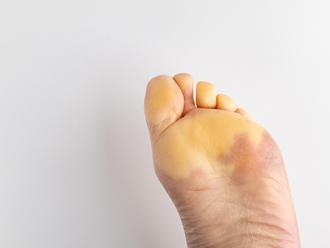What Is Raynaud’s Disease?

- posted: Mar. 14, 2022
Do your fingers and toes sometimes turn numb, change color, or feel cold? While this is a common response to winter weather, if you have Raynaud’s disease, something more could be going on to impact the health and function of your blood vessels. If you find your fingers or toes turning white and going numb, you should talk with your podiatrists about Raynaud’s disease.
What is Raynaud’s disease?
This rare disorder temporarily narrows or restricts blood flow to the blood vessels of the extremities. Raynaud’s disease is characterized by an attack and is often the result of cold weather exposure. There are two types of Raynaud’s disease: primary and secondary. Primary Raynaud’s disease occurs on its own without a cause while secondary Raynaud’s disease is the result of an underlying health problem.
What causes it?
Sometimes Raynaud’s disease has no known cause (as is the case with primary Raynaud’s disease); however, certain autoimmune diseases, extreme stress, or cold weather exposure are typically the main causes. Risk factors that can increase the likelihood of primary Raynaud’s disease include:
● Being a woman
● Being under 30 years old (symptoms offer appear during the teen years)
● A family history of Raynaud’s disease
Risk factors for secondary Raynaud’s disease include,
● Thyroid disorders, autoimmune diseases, and other chronic diseases
● Certain medications
● Exposure to certain chemicals, cold weather, or vibrating machines
What are the signs and symptoms?
When an attack occurs, skin on the toes and hands often turns white or pale. You may notice a loss of feeling in the extremities, as well. The area may also turn blue. Then once circulation returns, the area will warm and the skin will turn red. You may also notice burning, tingling, or throbbing as the sensation returns. Raynaud’s attack can last anywhere from several minutes to several hours.
How is Raynaud’s disease treated?
If a certain medication or underlying health problem is causing these attacks, your doctor may recommend switching medications or can help you better manage these chronic health problems to reduce your risks for an attack. If your primary Raynaud’s attacks are the result of cold exposure, avoiding cold temperatures is the best way to prevent attacks. Ensure that you are also properly bundled and wearing warm socks and gloves if you have to go outdoors on cold days.
Numbness and color changes in the feet can also be signs of diabetes and nerve damage, so it’s important that you see your podiatrist right away to rule out more serious health concerns.

- posted: Mar. 14, 2022
Do your fingers and toes sometimes turn numb, change color, or feel cold? While this is a common response to winter weather, if you have Raynaud’s disease, something more could be going on to impact the health and function of your blood vessels. If you find your fingers or toes turning white and going numb, you should talk with your podiatrists about Raynaud’s disease.
What is Raynaud’s disease?
This rare disorder temporarily narrows or restricts blood flow to the blood vessels of the extremities. Raynaud’s disease is characterized by an attack and is often the result of cold weather exposure. There are two types of Raynaud’s disease: primary and secondary. Primary Raynaud’s disease occurs on its own without a cause while secondary Raynaud’s disease is the result of an underlying health problem.
What causes it?
Sometimes Raynaud’s disease has no known cause (as is the case with primary Raynaud’s disease); however, certain autoimmune diseases, extreme stress, or cold weather exposure are typically the main causes. Risk factors that can increase the likelihood of primary Raynaud’s disease include:
● Being a woman
● Being under 30 years old (symptoms offer appear during the teen years)
● A family history of Raynaud’s disease
Risk factors for secondary Raynaud’s disease include,
● Thyroid disorders, autoimmune diseases, and other chronic diseases
● Certain medications
● Exposure to certain chemicals, cold weather, or vibrating machines
What are the signs and symptoms?
When an attack occurs, skin on the toes and hands often turns white or pale. You may notice a loss of feeling in the extremities, as well. The area may also turn blue. Then once circulation returns, the area will warm and the skin will turn red. You may also notice burning, tingling, or throbbing as the sensation returns. Raynaud’s attack can last anywhere from several minutes to several hours.
How is Raynaud’s disease treated?
If a certain medication or underlying health problem is causing these attacks, your doctor may recommend switching medications or can help you better manage these chronic health problems to reduce your risks for an attack. If your primary Raynaud’s attacks are the result of cold exposure, avoiding cold temperatures is the best way to prevent attacks. Ensure that you are also properly bundled and wearing warm socks and gloves if you have to go outdoors on cold days.
Numbness and color changes in the feet can also be signs of diabetes and nerve damage, so it’s important that you see your podiatrist right away to rule out more serious health concerns.
